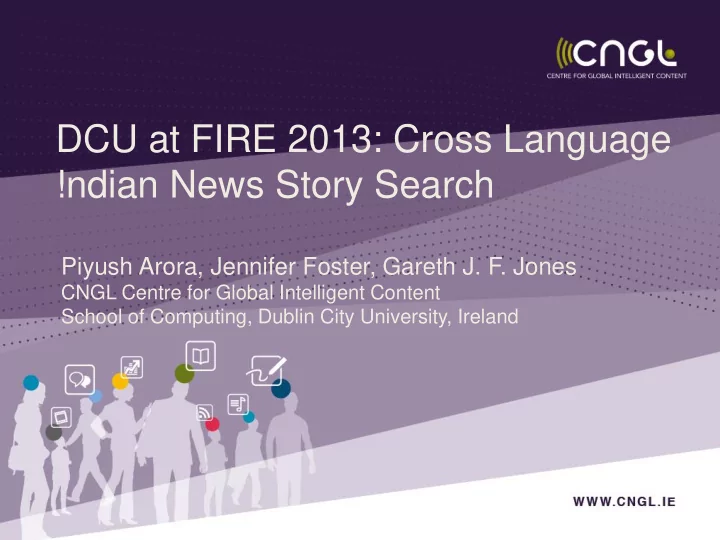

DCU at FIRE 2013: Cross Language !ndian News Story Search Piyush Arora, Jennifer Foster, Gareth J. F. Jones CNGL Centre for Global Intelligent Content School of Computing, Dublin City University, Ireland
Outline — Introduction — Our Approach — Experimental Details — Results — Conclusions and Future Work
Introduction CL!NSS FIRE'13 task: News story linking between English and Indian Languages documents.
Outline — Introduction — Our Approach — Experimental Details — Results — Conclusion and Future Work
Our Approach The approach used by us has 2 main steps: • Step-1 : Follow traditional cross-language information retrieval (CLIR) approach: Index documents using Lucene search engine. Translate input query from source to target language using machine translation (MT) Rank documents for retrieval using Lucene search engine • Step-2 : Combine multiple runs using data fusion methods
Contd… Novel features of our approach • Query modifications using different features such as: o Summarize query documents to form focused queries prior to translation o Identify Named Entities (NEs) as candidates for transliteration o Combine MT translation with NEs transliterations to capture alternative translations • Adding weighting to reflect publication date relationship between query and target documents
Outline — Introduction — Our Approach — Experimental Details — Results — Conclusion and Future Work
Experimental Details Pre-Processing and Indexing • Index documents using Lucene. • Used Lucene's inbuilt Hindi Analyzer • Stopword list obtained by concatenating the following: 1. FIRE Hindi stopword list 2. Lucene internal stopword list 3. Stopword list created by selecting all words with Document Frequency (DF) > 5000
Contd… Cross Language Search • Input queries translated separately using: • Bing • Google System NDCG@1 NDCG@5 NDCG@10 NDCG@20 Palkosvi 0.32 0.33 0.34 0.36 Bing 0.54 0.52 0.53 0.55 Google 0.56 0.55 0.56 0.58 Baseline Results
Main Features Used For Query Modifications Summarizer : based on extraction of sentences weighted using various factors indicating importance to document • Varying length of summary • Summary length half of query document • Summary length one third of query document • Summary of top 3 ranked sentences from query document. • Use alternative translation services: Bing, Google
Summarizer Features Main Features used for summarizer: — skimming: position of a sentence in a paragraph. — namedEntity: number of named entities in each sentence. — TSISF: similar to TF-IDF function but works at sentence level. — titleTerm: overlap between the sentences and the terms in the title of a document. — clusterKeyword: relatedness between words in a sentence.
Contd… Transliteration English Word Translated Word Transliterated Word गेमॎस खेल Games राष्टॎरमंडल कॉमनवेलॎथ Commonwealth Using Date Adding a constant of 0.04 to the retrieved documents occurring in a window of 10 days of the query document.
Feature Selection — Using Google translation • Using 1/3 summary • Using 3-sentence summary • Using 3-sentence summary + all NE transliterated • Using complete input query + all NE transliterated — Using Bing translation • Using 1/3 summary • Using 3-sentence summary • Using complete input query + all NE transliterated
System NDCG@1 NDCG@5 NDCG@10 NDCG@20 1/3 summary 0.5408 0.5814 0.5872 0.5907 1/3 summary+ 0.5408 0.5757 0.5828 0.5957 NE transliterated 3-sentence 0.5918 0.5815 0.5855 0.5897 summary Complete query 0.5714 0.562 0.5743 0.591 +NE transliterated Results Using Google Translation
System NDCG@1 NDCG@5 NDCG@10 NDCG@20 3-sentence 0.5612 0.556 0.5623 0.5734 summary 1/3 summary 0.551 0.555 0.5639 0.5721 0.5102 0.5315 0.5463 0.5574 Complete query + NE transliterated Results Using Bing Translation
Data Fusion
Top 3 feature/system combinations selected: • Run-1: Using Google translation and 1/3 summary of input query. • Run-2: Using Google translation and combining 1/3 summary with and without NE transliterated, 3-sentence summary and using whole query + incorporating date factor. • Run-3: Combining all the features, i.e. including queries translated using both Google and Bing using complete query as well as 1/3 summary and 3-sentence summary with and without NE transliterated.
System NDCG@1 NDCG@5 NDCG@10 NDCG@20 Run-1 0.5408 0.5814 0.5872 0.5907 Run-2 0.6224 0.5835 0.5943 0.6022 0.6224 0.5733 0.5833 0.5956 Run-3 Results on Training set
Outline — Introduction — Our Approach — Experimental Details — Results — Conclusion and Future Work
Results on test set Evaluation - Submitted runs blind – submission combinations selected using features that performed best on the training set System NDCG@1 NDCG@5 NDCG@10 NDCG@20 Run-1 0.74 0.66587 0.6759 0.6849 0.6701 0.7047 0.7042 Run-2 0.74 Run-3 0.74 0.6809 0.7268 0.7249 Results on Test set
Outline — Introduction — Our Approach — Experimental Details — Results — Conclusion and Future Work
Conclusion & Future Work Future Work: Handling abbreviations such as “MNK”, “YSR”, political • party names, movie names, etc. • Handling spelling variants. • Normalizing text, handling language variations. • Minimizing translation and transliteration error. • Explore alternative scoring functions such as BM25. • Weighting different features rather than linearly scoring them.
Thank You Questions? This research is supported by Science Foundation Ireland (SFI) as a part of the CNGL Centre for Global Intelligent Content at DCU (Grant NO: 12/CE/I2267)
Recommend
More recommend